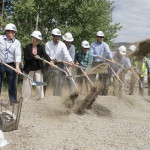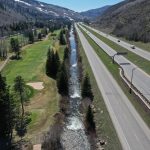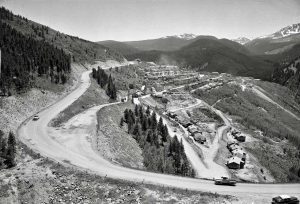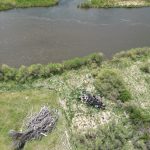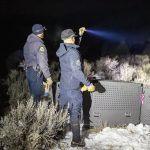Vail Valley roundabouts aren’t hard to navigate, with a few simple tips

What do we have?
There are three basic kinds of roundabouts in the Vail Valley:
• Three-lane: These are the roundabouts at the main Vail and West Vail Interstate interchanges, but only parts are three-laned.
• Two lanes: These are the most common, and are found in Vail, Avon, Edwards and Eagle.
• One lane: Only the roundabout in Gypsum remains a single-lane roundabout.
EAGLE COUNTY — Asking five people how to navigate the valley’s roundabouts is a little like asking five economists about foreign trade: You’re likely to get five different answers.
Roundabouts are well-established in the Vail Valley but are still relatively new in their modern form. In fact, when Vail’s first roundabouts were built in the 1990s, there were no federal standards for how traffic should flow through roundabouts, so they were built to British guidelines — except Americans don’t drive on the left side of the road.
Standards have developed over the years, and so has roundabout design.
Vail has a relatively new pair of roundabouts, at the Sandstone underpass below Interstate 70 that links the town’s North and South frontage roads.
Vail Town Engineer Tom Kassmel said the new roundabouts’ design doesn’t share much with the town’s first roundabouts — built both to ease monstrous traffic jams at the intersection of South Frontage Road and Vail Road and to avoid putting traffic lights in town.

Support Local Journalism
Over the years, engineers have learned more about math-intensive questions, including entry and exit angles, to make sure roundabouts can handle vehicles more safely.
All that math is important at Sandstone, since those roundabouts are pretty small. Kassmel said the Sandstone roundabouts are only about 110 feet in diameter. The main Vail roundabout on the south side of the interstate is a full 200 feet.
The Sandstone roundabouts also carry quite a bit less traffic, and are just two lanes, one for turning and one for going straight.
The Sandstone roundabouts are simplicity itself compared to a couple of the roundabouts at the interstate exits.
One circle, six exits
The roundabouts on South Frontage Road at the main Vail interchange and North Frontage Road at West Vail both have six access points. That can create confusion.
There are any number of scenarios for moving through those roundabouts, but the one many of us are familiar with is at West Vail. Kassmel was asked how he’d drive from one of the grocery stores in West Vail to westbound I-70.
The first rule is to be “careful and aware,” Kassmel said, advice that applies to roundabouts everywhere. But, in the case of driving from West Vail to I-70, a motorist passes the exits for Chamonix Road and the west portion of North Frontage Road before coming to the I-70 on ramp.
In that case, stay in the inside lane going into the roundabout from the east and then move to the right passing Chamonix Road to access the on ramp.
In fact, Kassmel’s advice is to stay to the inside most of the time.
In general, he said, motorists should yield to the vehicle on the left or inside.
“You look to the left, yield and go when it’s clear,” he said.
Eva Wilson has been the town of Avon’s mobility director for about the past 18 months. Before that, she was Eagle County’s lead engineer. In that role, Wilson helped with the design of the three roundabouts on the Edwards Spur Road between I-70 and U.S. Highway 6. She’s also familiar with the designs of the roundabouts in Eagle and Gypsum.
Asked for her advice driving through roundabouts, slowing down is near the top of Wilson’s to-do list. That gives motorists a chance to check the street markings for traffic flow.
Wilson also advises staying to the inside to go past an exit or two.
more forgiving intersections
If you happen to miss the road markings, then be careful, use your turn signal — which you should do anyway — and go around.
“Roundabouts are much more forgiving” than conventional intersections, Wilson said. “You should be able to maneuver and correct yourself.”
Wilson noted that studies indicate roundabouts can be safer than conventional intersections. There’s little chance of the T-bone collision common at stoplights and stop signs.
As director of mobility in Avon, Wilson’s job involves transit, cycling and pedestrian movement around town. While roundabouts don’t have traditional crosswalks, the crosswalks on Avon Road all have flashing lights to alert motorists that pedestrians are crossing.
In place for a few years now, Wilson said those crosswalks work well.
In fact, Vail has similar signs now.
Kassmel said pedestrians don’t always activate the signs, but encouraged them to do so.
“It’s very helpful,” he said.
Cyclists can also navigate roundabouts by traveling with traffic.
“Cyclists who are comfortable with riding with traffic can stay in a lane, and take a lane as if they’re in a vehicle,” Kassmel said. Those who’d rather not ride with traffic can dismount and use the pedestrian crossings.
Local drivers are largely familiar with roundabouts these days, and Kassmel said the Colorado Department of Transportation is working to have consistent signs and highway striping across the state. That consistency could help visitors to the state better understand roundabouts.
For veterans and rookies alike, though, the advice is the same, Kassmel said:
“Drive with care, and be aware.”
Vail Daily Business Editor Scott Miller can be reached at smiller@vaildaily.com and 970-748-2930.



